Financial Accounting Report on AASB 138 and Intangible Assets
VerifiedAdded on 2023/03/20
|9
|2938
|29
Report
AI Summary
This report provides a detailed analysis of the accounting treatment of intangible assets, specifically focusing on the application of AASB 138 and IAS 38 within Technology Enterprises Limited. It begins with an executive summary and table of contents, followed by an introduction that outlines the importance of accounting principles for intangible assets, including research and development expenses. The report addresses the accounting treatment of a specific project, utilizing the present value method and fair value accounting to determine the asset's value. It then delves into the definition of intangible assets according to AASB 138/IAS 38, including asset recognition, measurement, and the treatment of research costs. The report further examines the impact of AASB 138 on the comparability of financial statements, highlighting how differing valuation and recognition methods can affect users' ability to compare financial information across businesses. Finally, the report concludes with a summary of AASB 138, emphasizing its significance for Australian organizations and the guidelines it provides for accounting for intangible assets. The report recommends using the present value method and adhering to AASB 138 standards for the project's accounting treatment.
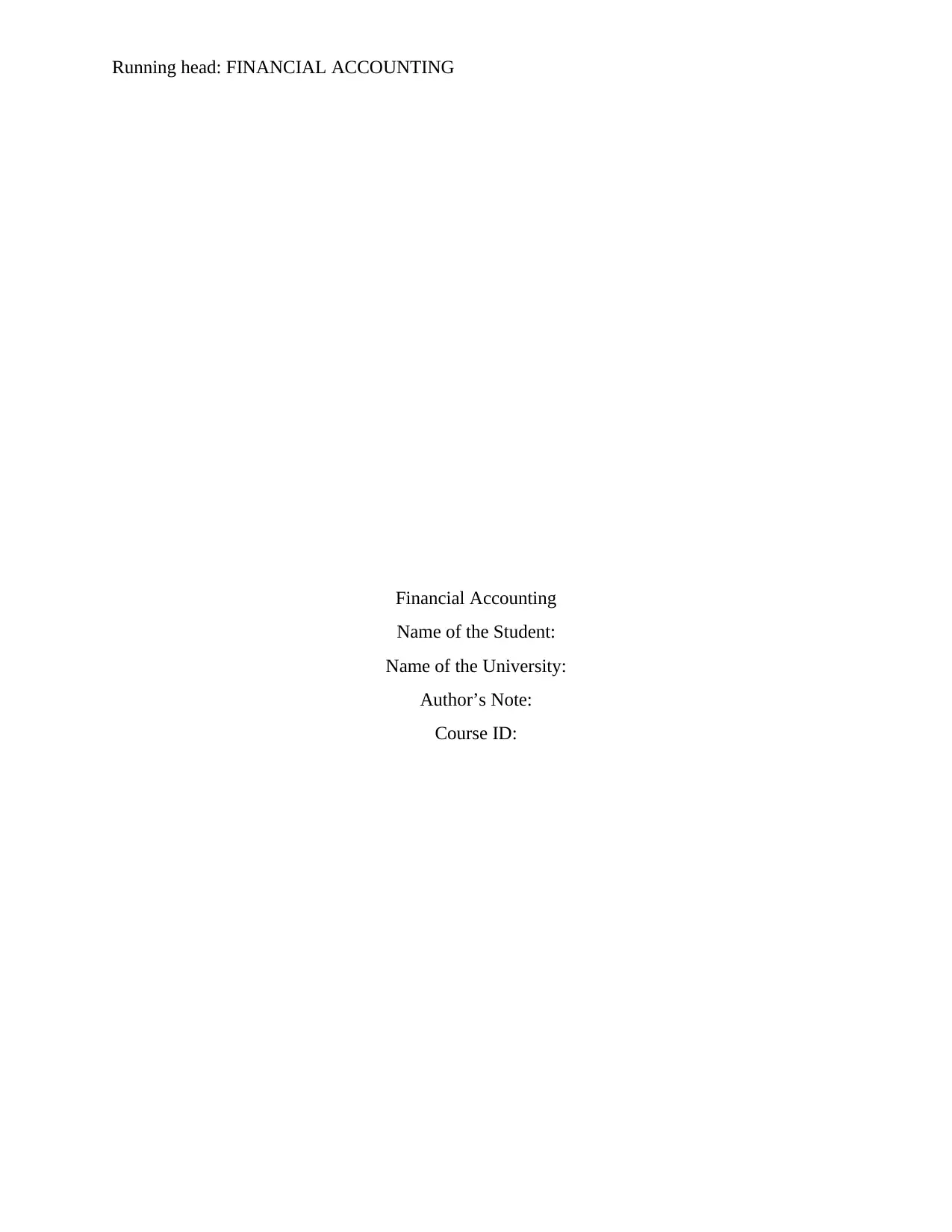
Running head: FINANCIAL ACCOUNTING
Financial Accounting
Name of the Student:
Name of the University:
Author’s Note:
Course ID:
Financial Accounting
Name of the Student:
Name of the University:
Author’s Note:
Course ID:
Paraphrase This Document
Need a fresh take? Get an instant paraphrase of this document with our AI Paraphraser
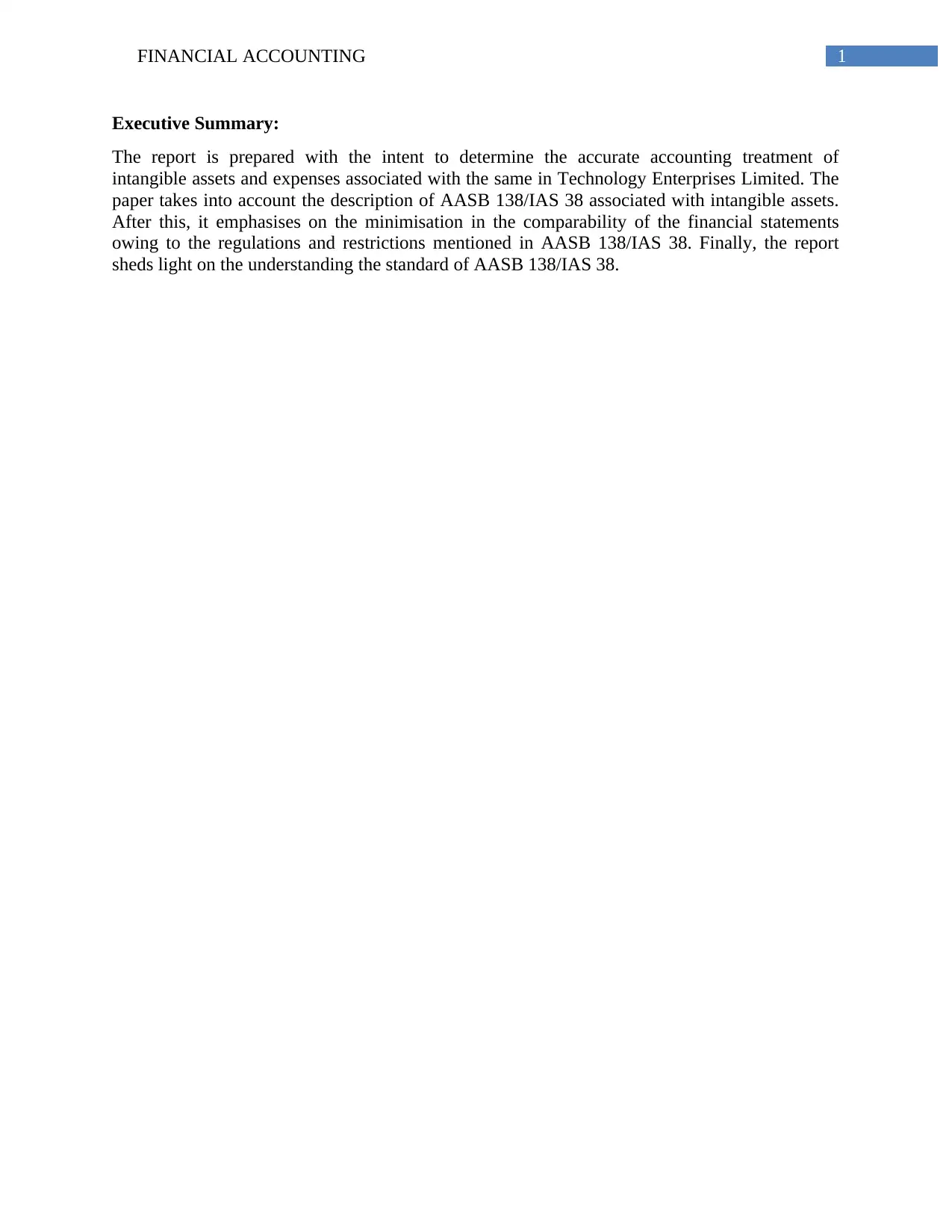
1FINANCIAL ACCOUNTING
Executive Summary:
The report is prepared with the intent to determine the accurate accounting treatment of
intangible assets and expenses associated with the same in Technology Enterprises Limited. The
paper takes into account the description of AASB 138/IAS 38 associated with intangible assets.
After this, it emphasises on the minimisation in the comparability of the financial statements
owing to the regulations and restrictions mentioned in AASB 138/IAS 38. Finally, the report
sheds light on the understanding the standard of AASB 138/IAS 38.
Executive Summary:
The report is prepared with the intent to determine the accurate accounting treatment of
intangible assets and expenses associated with the same in Technology Enterprises Limited. The
paper takes into account the description of AASB 138/IAS 38 associated with intangible assets.
After this, it emphasises on the minimisation in the comparability of the financial statements
owing to the regulations and restrictions mentioned in AASB 138/IAS 38. Finally, the report
sheds light on the understanding the standard of AASB 138/IAS 38.
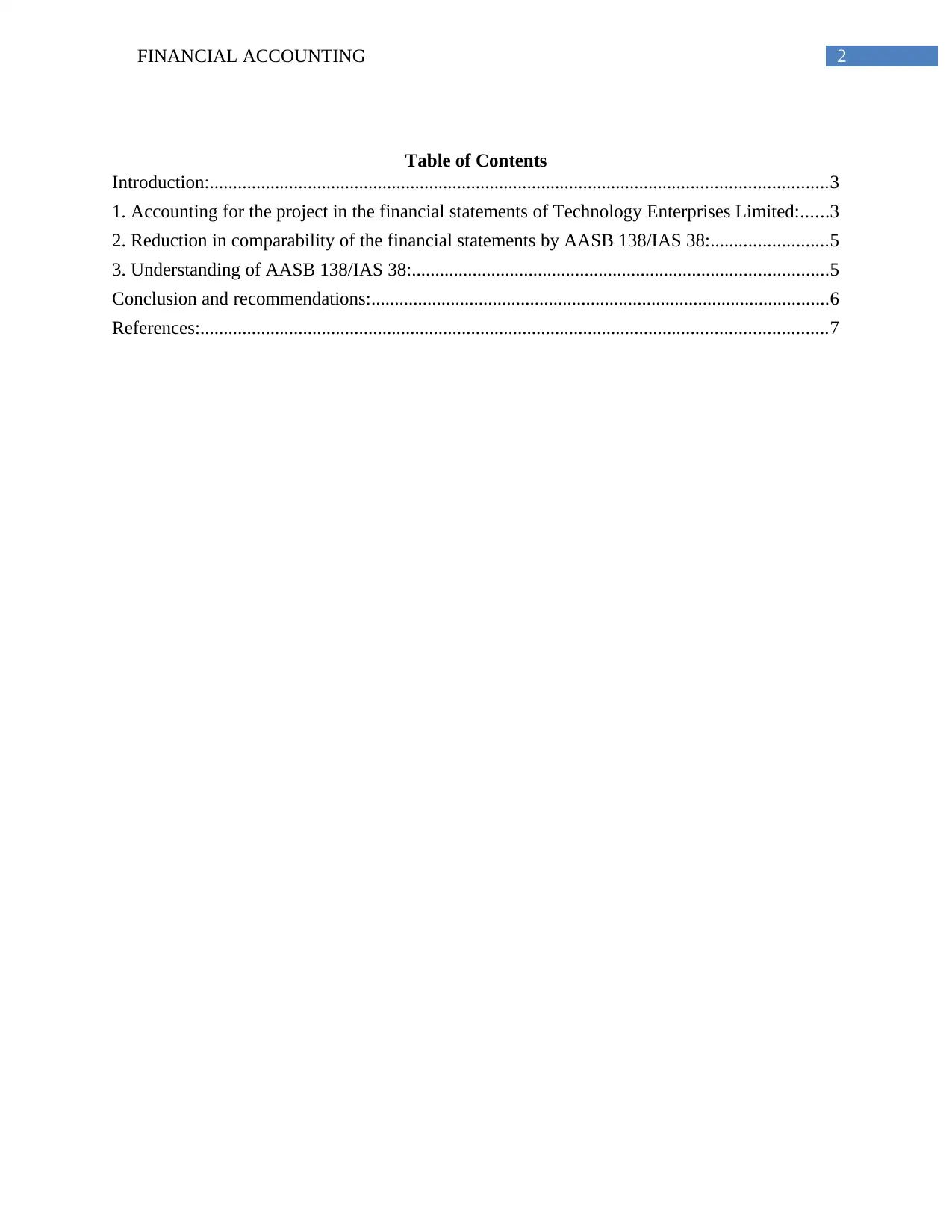
2FINANCIAL ACCOUNTING
Table of Contents
Introduction:....................................................................................................................................3
1. Accounting for the project in the financial statements of Technology Enterprises Limited:......3
2. Reduction in comparability of the financial statements by AASB 138/IAS 38:.........................5
3. Understanding of AASB 138/IAS 38:.........................................................................................5
Conclusion and recommendations:..................................................................................................6
References:......................................................................................................................................7
Table of Contents
Introduction:....................................................................................................................................3
1. Accounting for the project in the financial statements of Technology Enterprises Limited:......3
2. Reduction in comparability of the financial statements by AASB 138/IAS 38:.........................5
3. Understanding of AASB 138/IAS 38:.........................................................................................5
Conclusion and recommendations:..................................................................................................6
References:......................................................................................................................................7
You're viewing a preview
Unlock full access by subscribing today!

3FINANCIAL ACCOUNTING
Introduction:
All organisations regardless of their nature and size are liable to adhere to different
accounting policies and principles in order to carry out the accounting treatment of their assets
and liabilities, out of which intangible assets are deemed to be vital business assets. They have to
adhere to the accurate accounting principles and standards in relation to accounting treatment of
intangible assets and more specifically, they need to account for its research and development
(R&D) expenses in order to develop intangible assets (Clarke and Wilson, 2018). In Australia,
the organisations listed in ASX have to adhere to the standards and guidelines mentioned in
“AASB 138 Intangible Assets” in terms of accounting treatment of intangible assets along with
the research and development expenses associated with them.
Based on the given information of Technology Enterprises Limited, the accountant of the
organisation is confronted with significant uncertainty for dealing with the project. The report
intends to provide an overview of the accurate accounting treatment of the project undertaken by
the concerned organisation. Secondly, it emphasises on the minimisation in the comparability of
the financial statements owing to the regulations and restrictions mentioned in AASB 138/IAS
38. Finally, the report sheds light on the understanding the standard of AASB 138/IAS 38.
1. Accounting for the project in the financial statements of Technology Enterprises
Limited:
The present value method could be used for projecting the existing value of the project.
This is because it would assist in ascertaining the actual project value expected to be obtained by
Technology Enterprises Limited. According to fair value accounting, the design has value-in-use
of $4,000,000 and by using the present value method, the fair value of the design is estimated to
be $3,000,000. This makes the difference between the fair value and value-in-use of the design
evident, which could be depicted as follows:
$1,000,000 = $4,000,000 - $3,000,000
In accordance with the above numerical, a difference of $1,000,000 could be observed
between the price of market capitalisation and reported price and this needs to be taken into
account by the management of Technology Enterprises Limited.
AASB 138/IAS 38:
In accordance with the definition mentioned in AASB 138/IAS 38, intangible assets are
considered in the form of non-monetary and intangible assets of the organisations, which could
not be felt physically. When there is no clean existence, it is deemed to be the significant
characteristic of intangible assets as well as the nature of non-monetary values. Owing to this
reason, AASB 138/IAS 38 constitutes of the definition of both monetary assets and non-
monetary assets. An organisation has two alternatives associated with intangible assets, which
include either internal generation or acquisition of the same (Aasb.gov.au, 2019).
Intangible asset recognition:
In accordance with “AASB 138, Para 21”, the organisations are liable to realise
intangible assets in the presence of probability that the organisation would obtain expected future
Introduction:
All organisations regardless of their nature and size are liable to adhere to different
accounting policies and principles in order to carry out the accounting treatment of their assets
and liabilities, out of which intangible assets are deemed to be vital business assets. They have to
adhere to the accurate accounting principles and standards in relation to accounting treatment of
intangible assets and more specifically, they need to account for its research and development
(R&D) expenses in order to develop intangible assets (Clarke and Wilson, 2018). In Australia,
the organisations listed in ASX have to adhere to the standards and guidelines mentioned in
“AASB 138 Intangible Assets” in terms of accounting treatment of intangible assets along with
the research and development expenses associated with them.
Based on the given information of Technology Enterprises Limited, the accountant of the
organisation is confronted with significant uncertainty for dealing with the project. The report
intends to provide an overview of the accurate accounting treatment of the project undertaken by
the concerned organisation. Secondly, it emphasises on the minimisation in the comparability of
the financial statements owing to the regulations and restrictions mentioned in AASB 138/IAS
38. Finally, the report sheds light on the understanding the standard of AASB 138/IAS 38.
1. Accounting for the project in the financial statements of Technology Enterprises
Limited:
The present value method could be used for projecting the existing value of the project.
This is because it would assist in ascertaining the actual project value expected to be obtained by
Technology Enterprises Limited. According to fair value accounting, the design has value-in-use
of $4,000,000 and by using the present value method, the fair value of the design is estimated to
be $3,000,000. This makes the difference between the fair value and value-in-use of the design
evident, which could be depicted as follows:
$1,000,000 = $4,000,000 - $3,000,000
In accordance with the above numerical, a difference of $1,000,000 could be observed
between the price of market capitalisation and reported price and this needs to be taken into
account by the management of Technology Enterprises Limited.
AASB 138/IAS 38:
In accordance with the definition mentioned in AASB 138/IAS 38, intangible assets are
considered in the form of non-monetary and intangible assets of the organisations, which could
not be felt physically. When there is no clean existence, it is deemed to be the significant
characteristic of intangible assets as well as the nature of non-monetary values. Owing to this
reason, AASB 138/IAS 38 constitutes of the definition of both monetary assets and non-
monetary assets. An organisation has two alternatives associated with intangible assets, which
include either internal generation or acquisition of the same (Aasb.gov.au, 2019).
Intangible asset recognition:
In accordance with “AASB 138, Para 21”, the organisations are liable to realise
intangible assets in the presence of probability that the organisation would obtain expected future
Paraphrase This Document
Need a fresh take? Get an instant paraphrase of this document with our AI Paraphraser

4FINANCIAL ACCOUNTING
benefits related to the assets, while the asset costs could be gauged with reliability. Owing to this
reason, the organisation is needed to assure that the exclusion of expenses and costs incurred in
the form of benefit for the organisation after the research costs incurred have been subtracted
(Bodle, et al., 2018). For Technology Enterprises Limited, it is apparent that the organisation has
incurred various costs, which are represented as follows:
Particulars Amount (in $)
Cost of time incurred searching for and analysis of alternative materials 100,000
Cost of time for design of models and construction and testing of protocols 700,000
Cost of time incurred on training maintenance staffs for new design 200,000
Total cost incurred 1,000,000
From the above table, it could be observed that Technology Enterprises Limited has spent
$1,000,000 for different purposes in order to develop the design. Therefore, it is necessary for
the organisation in order to realise the amount in the form of expenses.
Measurement of intangible assets:
As evident from “AASB 138, Para 24”, an organisation is needed to assure that an
intangible asset is gauged at cost and Technology Enterprises Limited is not an exception to this
situation as well. Therefore, it needs to measure its design at cost in the initial stage, which is
$4,000,000. The expenses that Technology Enterprises Limited has incurred for design
development need to be taken into account in the form of R&D costs and AASB 138 enforces
liability on the organisation to recognise its R&D costs as sunk cost in the consolidated income
statement. It is noteworthy to mention that Technology Enterprises Limited could generate
intangible asset internally within the organisation for specific timeframe. When an intangible
asset is acquired from business combinations, the organisations need to represent the excess of
purchase consideration in the form of goodwill (Fraser, 2018).
Research cost:
“AASB 138, Para 8” needs an organisation to carry out detailed and planned inquiry so
that it could be able to obtain sound scientific and technical knowledge on research cost. For
Technology Enterprises Limited, the cost that the organisation has incurred is to raise the useful
lives of the batteries in order to generate cash flows for four years by fully adhering to the
guidelines mentioned in AASB 138. Hence, the research cost amounting to $100,000 has to be
taken into account in the form of expenses under the sunk cost category (Garg, 2017).
Asset development:
According to AASB 138, an asset is developed by an organisation after there is
completion of the research project. The organisation has to realise the asset after its technical
viability is tested providing the organisation with the alternative to utilise along with selling the
asset (Ho Kim and Taylor, 2014). In order to identify the value of the asset in the balance sheet
statement, it is necessary to identify properly the accounting standard and this is deemed to be a
vital aspect after the feasibility test. Technology Enterprises Limited has incurred considerable
benefits related to the assets, while the asset costs could be gauged with reliability. Owing to this
reason, the organisation is needed to assure that the exclusion of expenses and costs incurred in
the form of benefit for the organisation after the research costs incurred have been subtracted
(Bodle, et al., 2018). For Technology Enterprises Limited, it is apparent that the organisation has
incurred various costs, which are represented as follows:
Particulars Amount (in $)
Cost of time incurred searching for and analysis of alternative materials 100,000
Cost of time for design of models and construction and testing of protocols 700,000
Cost of time incurred on training maintenance staffs for new design 200,000
Total cost incurred 1,000,000
From the above table, it could be observed that Technology Enterprises Limited has spent
$1,000,000 for different purposes in order to develop the design. Therefore, it is necessary for
the organisation in order to realise the amount in the form of expenses.
Measurement of intangible assets:
As evident from “AASB 138, Para 24”, an organisation is needed to assure that an
intangible asset is gauged at cost and Technology Enterprises Limited is not an exception to this
situation as well. Therefore, it needs to measure its design at cost in the initial stage, which is
$4,000,000. The expenses that Technology Enterprises Limited has incurred for design
development need to be taken into account in the form of R&D costs and AASB 138 enforces
liability on the organisation to recognise its R&D costs as sunk cost in the consolidated income
statement. It is noteworthy to mention that Technology Enterprises Limited could generate
intangible asset internally within the organisation for specific timeframe. When an intangible
asset is acquired from business combinations, the organisations need to represent the excess of
purchase consideration in the form of goodwill (Fraser, 2018).
Research cost:
“AASB 138, Para 8” needs an organisation to carry out detailed and planned inquiry so
that it could be able to obtain sound scientific and technical knowledge on research cost. For
Technology Enterprises Limited, the cost that the organisation has incurred is to raise the useful
lives of the batteries in order to generate cash flows for four years by fully adhering to the
guidelines mentioned in AASB 138. Hence, the research cost amounting to $100,000 has to be
taken into account in the form of expenses under the sunk cost category (Garg, 2017).
Asset development:
According to AASB 138, an asset is developed by an organisation after there is
completion of the research project. The organisation has to realise the asset after its technical
viability is tested providing the organisation with the alternative to utilise along with selling the
asset (Ho Kim and Taylor, 2014). In order to identify the value of the asset in the balance sheet
statement, it is necessary to identify properly the accounting standard and this is deemed to be a
vital aspect after the feasibility test. Technology Enterprises Limited has incurred considerable
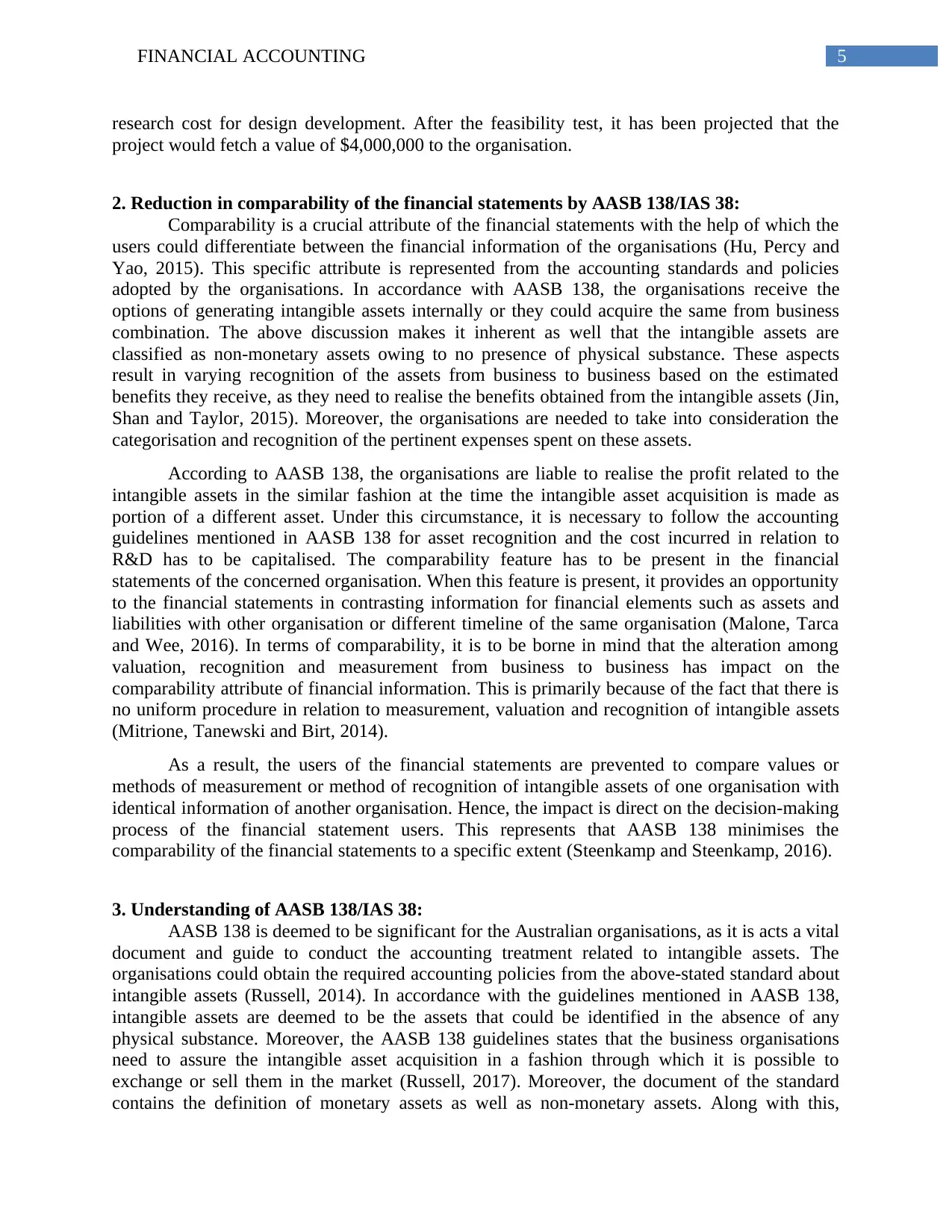
5FINANCIAL ACCOUNTING
research cost for design development. After the feasibility test, it has been projected that the
project would fetch a value of $4,000,000 to the organisation.
2. Reduction in comparability of the financial statements by AASB 138/IAS 38:
Comparability is a crucial attribute of the financial statements with the help of which the
users could differentiate between the financial information of the organisations (Hu, Percy and
Yao, 2015). This specific attribute is represented from the accounting standards and policies
adopted by the organisations. In accordance with AASB 138, the organisations receive the
options of generating intangible assets internally or they could acquire the same from business
combination. The above discussion makes it inherent as well that the intangible assets are
classified as non-monetary assets owing to no presence of physical substance. These aspects
result in varying recognition of the assets from business to business based on the estimated
benefits they receive, as they need to realise the benefits obtained from the intangible assets (Jin,
Shan and Taylor, 2015). Moreover, the organisations are needed to take into consideration the
categorisation and recognition of the pertinent expenses spent on these assets.
According to AASB 138, the organisations are liable to realise the profit related to the
intangible assets in the similar fashion at the time the intangible asset acquisition is made as
portion of a different asset. Under this circumstance, it is necessary to follow the accounting
guidelines mentioned in AASB 138 for asset recognition and the cost incurred in relation to
R&D has to be capitalised. The comparability feature has to be present in the financial
statements of the concerned organisation. When this feature is present, it provides an opportunity
to the financial statements in contrasting information for financial elements such as assets and
liabilities with other organisation or different timeline of the same organisation (Malone, Tarca
and Wee, 2016). In terms of comparability, it is to be borne in mind that the alteration among
valuation, recognition and measurement from business to business has impact on the
comparability attribute of financial information. This is primarily because of the fact that there is
no uniform procedure in relation to measurement, valuation and recognition of intangible assets
(Mitrione, Tanewski and Birt, 2014).
As a result, the users of the financial statements are prevented to compare values or
methods of measurement or method of recognition of intangible assets of one organisation with
identical information of another organisation. Hence, the impact is direct on the decision-making
process of the financial statement users. This represents that AASB 138 minimises the
comparability of the financial statements to a specific extent (Steenkamp and Steenkamp, 2016).
3. Understanding of AASB 138/IAS 38:
AASB 138 is deemed to be significant for the Australian organisations, as it is acts a vital
document and guide to conduct the accounting treatment related to intangible assets. The
organisations could obtain the required accounting policies from the above-stated standard about
intangible assets (Russell, 2014). In accordance with the guidelines mentioned in AASB 138,
intangible assets are deemed to be the assets that could be identified in the absence of any
physical substance. Moreover, the AASB 138 guidelines states that the business organisations
need to assure the intangible asset acquisition in a fashion through which it is possible to
exchange or sell them in the market (Russell, 2017). Moreover, the document of the standard
contains the definition of monetary assets as well as non-monetary assets. Along with this,
research cost for design development. After the feasibility test, it has been projected that the
project would fetch a value of $4,000,000 to the organisation.
2. Reduction in comparability of the financial statements by AASB 138/IAS 38:
Comparability is a crucial attribute of the financial statements with the help of which the
users could differentiate between the financial information of the organisations (Hu, Percy and
Yao, 2015). This specific attribute is represented from the accounting standards and policies
adopted by the organisations. In accordance with AASB 138, the organisations receive the
options of generating intangible assets internally or they could acquire the same from business
combination. The above discussion makes it inherent as well that the intangible assets are
classified as non-monetary assets owing to no presence of physical substance. These aspects
result in varying recognition of the assets from business to business based on the estimated
benefits they receive, as they need to realise the benefits obtained from the intangible assets (Jin,
Shan and Taylor, 2015). Moreover, the organisations are needed to take into consideration the
categorisation and recognition of the pertinent expenses spent on these assets.
According to AASB 138, the organisations are liable to realise the profit related to the
intangible assets in the similar fashion at the time the intangible asset acquisition is made as
portion of a different asset. Under this circumstance, it is necessary to follow the accounting
guidelines mentioned in AASB 138 for asset recognition and the cost incurred in relation to
R&D has to be capitalised. The comparability feature has to be present in the financial
statements of the concerned organisation. When this feature is present, it provides an opportunity
to the financial statements in contrasting information for financial elements such as assets and
liabilities with other organisation or different timeline of the same organisation (Malone, Tarca
and Wee, 2016). In terms of comparability, it is to be borne in mind that the alteration among
valuation, recognition and measurement from business to business has impact on the
comparability attribute of financial information. This is primarily because of the fact that there is
no uniform procedure in relation to measurement, valuation and recognition of intangible assets
(Mitrione, Tanewski and Birt, 2014).
As a result, the users of the financial statements are prevented to compare values or
methods of measurement or method of recognition of intangible assets of one organisation with
identical information of another organisation. Hence, the impact is direct on the decision-making
process of the financial statement users. This represents that AASB 138 minimises the
comparability of the financial statements to a specific extent (Steenkamp and Steenkamp, 2016).
3. Understanding of AASB 138/IAS 38:
AASB 138 is deemed to be significant for the Australian organisations, as it is acts a vital
document and guide to conduct the accounting treatment related to intangible assets. The
organisations could obtain the required accounting policies from the above-stated standard about
intangible assets (Russell, 2014). In accordance with the guidelines mentioned in AASB 138,
intangible assets are deemed to be the assets that could be identified in the absence of any
physical substance. Moreover, the AASB 138 guidelines states that the business organisations
need to assure the intangible asset acquisition in a fashion through which it is possible to
exchange or sell them in the market (Russell, 2017). Moreover, the document of the standard
contains the definition of monetary assets as well as non-monetary assets. Along with this,
You're viewing a preview
Unlock full access by subscribing today!

6FINANCIAL ACCOUNTING
AASB 138 provides alternative to the organisations, in which they could either generate
intangible assets generally or the same could be obtained from business combination leading to
goodwill recognition in the form of excess of purchase consideration (Standard, 2015).
AASB 138 needs the organisations to assure the measurement of intangible assets at cost
in the initial stage and the internally generated intangible assets have to be reported at cost value
as well. When the intangible assets are recognised, the organisations require ensuring the
presence of a chance that the future economic benefits associated with these assets would be
flown towards them and these asset costs could be measured with reliability (Su and Wells,
2018). Moreover, the standard states that the organisations need to realise the costs spent in order
to generate intangible assets in the form of research and development that have to be disclosed in
the consolidated income statement in the form of sunk cost. The viability of these assets has to be
gauged by the organisations when these assets would be reported in the consolidated statements
of financial position of the organisations (Yao, Percy and Hu, 2015).
Conclusion and recommendations:
Based on the above discussion, it could be stated that Technology Enterprises Limited
needs to use the present value method in order to estimate the value of the research and
development project. In order to conduct the accounting treatment for this project, the
organisation has to adhere to the guidelines and standards mentioned in AASB 138. It has been
evaluated that intangible assets take into consideration monetary as well as non-monetary assets,
It is the liability of the organisations to assure that the values of assets and liabilities are
disclosed aptly in the financial statement while adhering to the necessary accounting principles
and guidelines. In case of Technology Enterprises Limited, the issue of the investors could be
minimised, if the management of the organisation provides certain vital disclosures about the
financial aspects such as intangible assets. The organisations are deemed to be accountable to
report the asset values regularly and timely.
The management of Technology Enterprises Limited is advised to conduct estimation and
valuation of the intangible assets after analysing the financial feasibility of such assets. For
ensuring the same, it is necessary for the management of the concerned organisation to follow
the policies and regulations in order to assure disclosure and adherence associated with the
financial assets. Such disclosures with respect to the financial elements of the organisation play a
considerable role in the analysis of financial information along with the explanations of the
assets and liabilities of the organisation. Technology Enterprises Limited is not an exemption
from this condition as well and they have to follow the same guidelines for ensuring the flow of
economic benefits towards the organisation.
AASB 138 provides alternative to the organisations, in which they could either generate
intangible assets generally or the same could be obtained from business combination leading to
goodwill recognition in the form of excess of purchase consideration (Standard, 2015).
AASB 138 needs the organisations to assure the measurement of intangible assets at cost
in the initial stage and the internally generated intangible assets have to be reported at cost value
as well. When the intangible assets are recognised, the organisations require ensuring the
presence of a chance that the future economic benefits associated with these assets would be
flown towards them and these asset costs could be measured with reliability (Su and Wells,
2018). Moreover, the standard states that the organisations need to realise the costs spent in order
to generate intangible assets in the form of research and development that have to be disclosed in
the consolidated income statement in the form of sunk cost. The viability of these assets has to be
gauged by the organisations when these assets would be reported in the consolidated statements
of financial position of the organisations (Yao, Percy and Hu, 2015).
Conclusion and recommendations:
Based on the above discussion, it could be stated that Technology Enterprises Limited
needs to use the present value method in order to estimate the value of the research and
development project. In order to conduct the accounting treatment for this project, the
organisation has to adhere to the guidelines and standards mentioned in AASB 138. It has been
evaluated that intangible assets take into consideration monetary as well as non-monetary assets,
It is the liability of the organisations to assure that the values of assets and liabilities are
disclosed aptly in the financial statement while adhering to the necessary accounting principles
and guidelines. In case of Technology Enterprises Limited, the issue of the investors could be
minimised, if the management of the organisation provides certain vital disclosures about the
financial aspects such as intangible assets. The organisations are deemed to be accountable to
report the asset values regularly and timely.
The management of Technology Enterprises Limited is advised to conduct estimation and
valuation of the intangible assets after analysing the financial feasibility of such assets. For
ensuring the same, it is necessary for the management of the concerned organisation to follow
the policies and regulations in order to assure disclosure and adherence associated with the
financial assets. Such disclosures with respect to the financial elements of the organisation play a
considerable role in the analysis of financial information along with the explanations of the
assets and liabilities of the organisation. Technology Enterprises Limited is not an exemption
from this condition as well and they have to follow the same guidelines for ensuring the flow of
economic benefits towards the organisation.
Paraphrase This Document
Need a fresh take? Get an instant paraphrase of this document with our AI Paraphraser
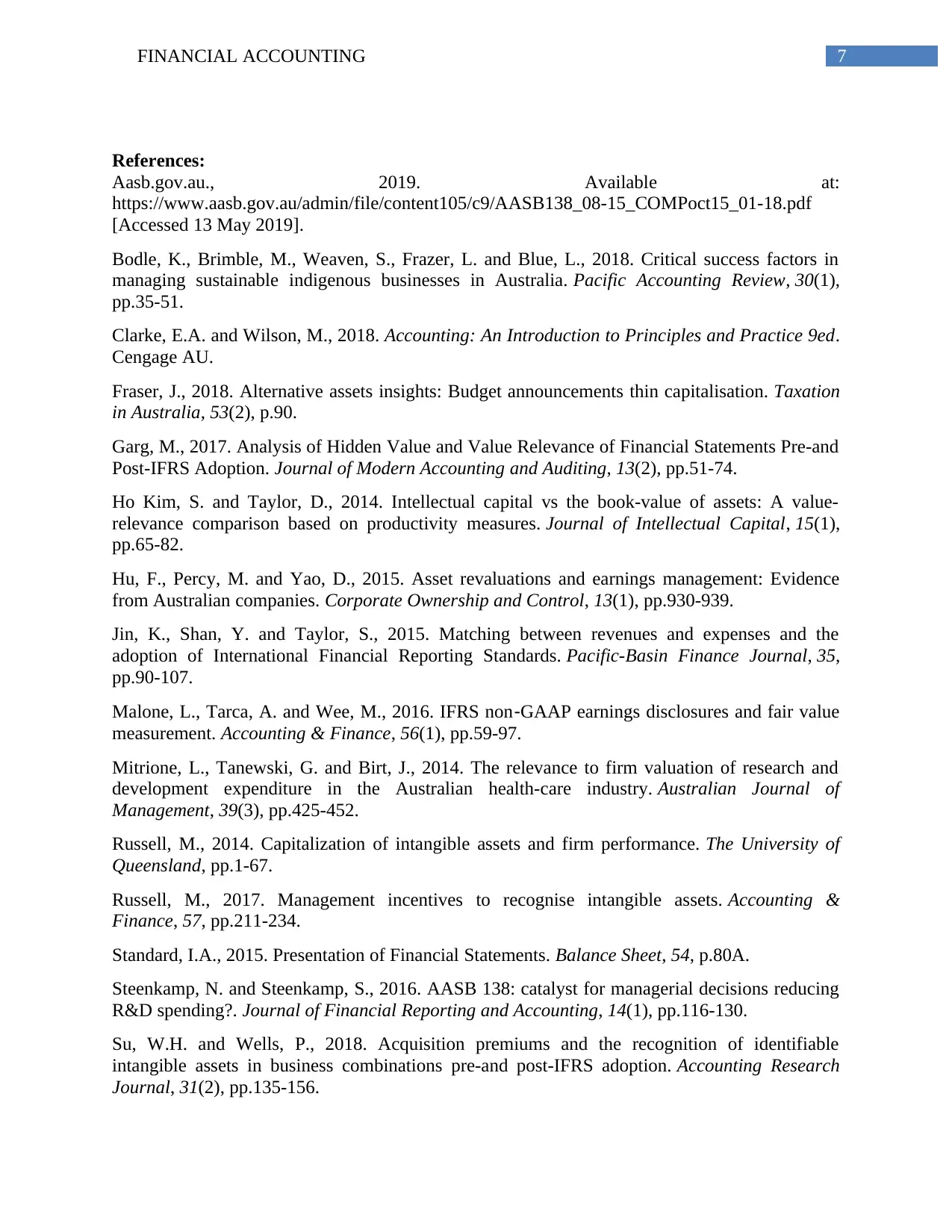
7FINANCIAL ACCOUNTING
References:
Aasb.gov.au., 2019. Available at:
https://www.aasb.gov.au/admin/file/content105/c9/AASB138_08-15_COMPoct15_01-18.pdf
[Accessed 13 May 2019].
Bodle, K., Brimble, M., Weaven, S., Frazer, L. and Blue, L., 2018. Critical success factors in
managing sustainable indigenous businesses in Australia. Pacific Accounting Review, 30(1),
pp.35-51.
Clarke, E.A. and Wilson, M., 2018. Accounting: An Introduction to Principles and Practice 9ed.
Cengage AU.
Fraser, J., 2018. Alternative assets insights: Budget announcements thin capitalisation. Taxation
in Australia, 53(2), p.90.
Garg, M., 2017. Analysis of Hidden Value and Value Relevance of Financial Statements Pre-and
Post-IFRS Adoption. Journal of Modern Accounting and Auditing, 13(2), pp.51-74.
Ho Kim, S. and Taylor, D., 2014. Intellectual capital vs the book-value of assets: A value-
relevance comparison based on productivity measures. Journal of Intellectual Capital, 15(1),
pp.65-82.
Hu, F., Percy, M. and Yao, D., 2015. Asset revaluations and earnings management: Evidence
from Australian companies. Corporate Ownership and Control, 13(1), pp.930-939.
Jin, K., Shan, Y. and Taylor, S., 2015. Matching between revenues and expenses and the
adoption of International Financial Reporting Standards. Pacific-Basin Finance Journal, 35,
pp.90-107.
Malone, L., Tarca, A. and Wee, M., 2016. IFRS non‐GAAP earnings disclosures and fair value
measurement. Accounting & Finance, 56(1), pp.59-97.
Mitrione, L., Tanewski, G. and Birt, J., 2014. The relevance to firm valuation of research and
development expenditure in the Australian health-care industry. Australian Journal of
Management, 39(3), pp.425-452.
Russell, M., 2014. Capitalization of intangible assets and firm performance. The University of
Queensland, pp.1-67.
Russell, M., 2017. Management incentives to recognise intangible assets. Accounting &
Finance, 57, pp.211-234.
Standard, I.A., 2015. Presentation of Financial Statements. Balance Sheet, 54, p.80A.
Steenkamp, N. and Steenkamp, S., 2016. AASB 138: catalyst for managerial decisions reducing
R&D spending?. Journal of Financial Reporting and Accounting, 14(1), pp.116-130.
Su, W.H. and Wells, P., 2018. Acquisition premiums and the recognition of identifiable
intangible assets in business combinations pre-and post-IFRS adoption. Accounting Research
Journal, 31(2), pp.135-156.
References:
Aasb.gov.au., 2019. Available at:
https://www.aasb.gov.au/admin/file/content105/c9/AASB138_08-15_COMPoct15_01-18.pdf
[Accessed 13 May 2019].
Bodle, K., Brimble, M., Weaven, S., Frazer, L. and Blue, L., 2018. Critical success factors in
managing sustainable indigenous businesses in Australia. Pacific Accounting Review, 30(1),
pp.35-51.
Clarke, E.A. and Wilson, M., 2018. Accounting: An Introduction to Principles and Practice 9ed.
Cengage AU.
Fraser, J., 2018. Alternative assets insights: Budget announcements thin capitalisation. Taxation
in Australia, 53(2), p.90.
Garg, M., 2017. Analysis of Hidden Value and Value Relevance of Financial Statements Pre-and
Post-IFRS Adoption. Journal of Modern Accounting and Auditing, 13(2), pp.51-74.
Ho Kim, S. and Taylor, D., 2014. Intellectual capital vs the book-value of assets: A value-
relevance comparison based on productivity measures. Journal of Intellectual Capital, 15(1),
pp.65-82.
Hu, F., Percy, M. and Yao, D., 2015. Asset revaluations and earnings management: Evidence
from Australian companies. Corporate Ownership and Control, 13(1), pp.930-939.
Jin, K., Shan, Y. and Taylor, S., 2015. Matching between revenues and expenses and the
adoption of International Financial Reporting Standards. Pacific-Basin Finance Journal, 35,
pp.90-107.
Malone, L., Tarca, A. and Wee, M., 2016. IFRS non‐GAAP earnings disclosures and fair value
measurement. Accounting & Finance, 56(1), pp.59-97.
Mitrione, L., Tanewski, G. and Birt, J., 2014. The relevance to firm valuation of research and
development expenditure in the Australian health-care industry. Australian Journal of
Management, 39(3), pp.425-452.
Russell, M., 2014. Capitalization of intangible assets and firm performance. The University of
Queensland, pp.1-67.
Russell, M., 2017. Management incentives to recognise intangible assets. Accounting &
Finance, 57, pp.211-234.
Standard, I.A., 2015. Presentation of Financial Statements. Balance Sheet, 54, p.80A.
Steenkamp, N. and Steenkamp, S., 2016. AASB 138: catalyst for managerial decisions reducing
R&D spending?. Journal of Financial Reporting and Accounting, 14(1), pp.116-130.
Su, W.H. and Wells, P., 2018. Acquisition premiums and the recognition of identifiable
intangible assets in business combinations pre-and post-IFRS adoption. Accounting Research
Journal, 31(2), pp.135-156.
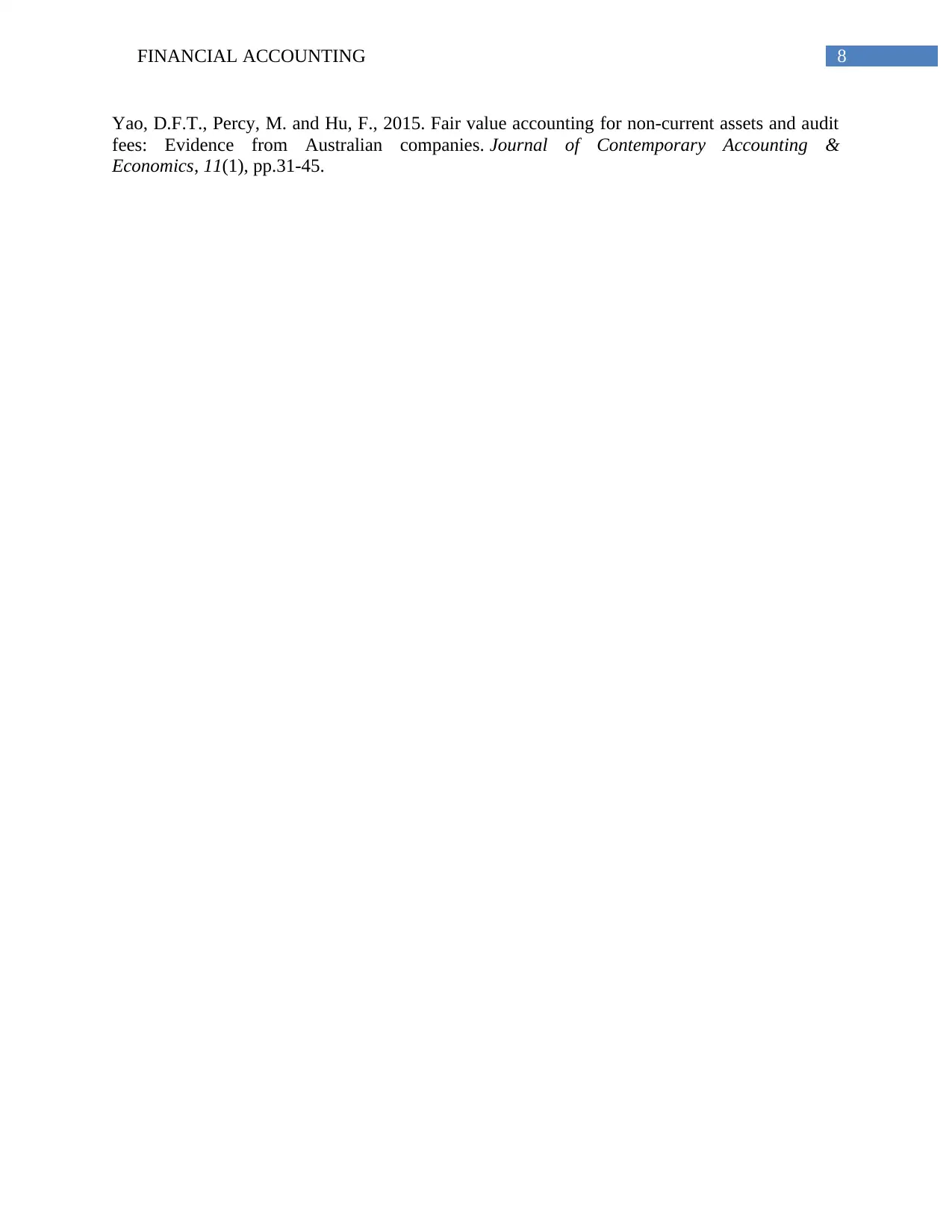
8FINANCIAL ACCOUNTING
Yao, D.F.T., Percy, M. and Hu, F., 2015. Fair value accounting for non-current assets and audit
fees: Evidence from Australian companies. Journal of Contemporary Accounting &
Economics, 11(1), pp.31-45.
Yao, D.F.T., Percy, M. and Hu, F., 2015. Fair value accounting for non-current assets and audit
fees: Evidence from Australian companies. Journal of Contemporary Accounting &
Economics, 11(1), pp.31-45.
You're viewing a preview
Unlock full access by subscribing today!
1 out of 9
Related Documents
Your All-in-One AI-Powered Toolkit for Academic Success.
+13062052269
info@desklib.com
Available 24*7 on WhatsApp / Email
![[object Object]](/_next/static/media/star-bottom.7253800d.svg)
Unlock your academic potential
© 2024 | Zucol Services PVT LTD | All rights reserved.





